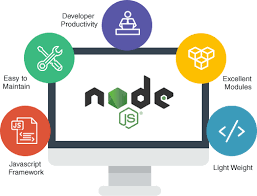
iOS Development
22 Dec 2023
Node.js Performance Optimization Techniques Every Developer Should Know

Node.js has become a popular choice for building scalable and high-performance web applications. However, as your application grows, you may encounter performance bottlenecks that can affect the user experience. In this article, we will explore essential Node JS development company performance optimization techniques that every developer should be familiar with to ensure their applications run smoothly and efficiently.
Before diving into optimizations, it's crucial to identify performance bottlenecks. Utilize tools like Node.js built-in profiler, V8 profiler, or third-party tools like clinic.js and New Relic. Profiling helps you understand where your application spends most of its time, allowing you to focus your optimization efforts on the critical areas.
Caching is a powerful technique to reduce response times and enhance performance. Implement caching at different levels: application-level caching, in-memory caching using tools like Redis, and content delivery network (CDN) caching for static assets. Caching can significantly reduce the load on your server by serving frequently requested data from a cache rather than regenerating it on every request.
Database queries often contribute to performance bottlenecks. Optimize your queries by indexing frequently used fields, using appropriate join strategies, and avoiding unnecessary queries. Consider using an Object-Relational Mapping (ORM) library like Sequelize or Mongoose, which can help optimize and abstract away some of the database-related complexities.
Node.js is single-threaded, but it supports concurrency through an event-driven, non-blocking I/O model. Leverage this model by using the cluster module to create multiple worker processes that can handle requests concurrently. Additionally, consider using tools like the async library or native Promises to handle asynchronous operations in a more organized and efficient manner.
Distribute incoming traffic across multiple server instances using load balancing. This helps in achieving better resource utilization and scalability. Popular tools like Nginx and HAProxy can be used for load balancing. Additionally, cloud providers often offer load balancing services that can be easily integrated into your infrastructure.
Regularly update your dependencies to benefit from performance improvements and security updates. Use tools like npm audit to identify and address security vulnerabilities in your dependencies. Minimize the number of dependencies and only include the modules you truly need to reduce the application's footprint.
Reduce the amount of data transmitted between the server and clients by enabling compression. Node.js supports response compression through modules like compression. This can significantly improve the speed of your application, especially for clients on slower networks.
Enable Gzip compression for static assets to further reduce the size of files sent over the network. This is particularly effective for large files like stylesheets and scripts. Many web servers and frameworks, including Express.js, provide easy ways to enable Gzip compression.
Optimize and minify your frontend assets, such as CSS, JavaScript, and images. Tools like Webpack and Babel can help bundle and minify your scripts, reducing their size and improving load times. Additionally, consider lazy loading assets to load only what is necessary for the current page, improving initial page load times.
Implement robust monitoring and logging solutions to keep track of your application's performance in real-time. Tools like Prometheus and Grafana can help you create dashboards and set up alerts for abnormal behavior. Detailed logs can provide insights into issues, helping you diagnose and address performance problems promptly.
Node JS development company offers a powerful platform for building scalable and performant applications, but optimizing for performance is an ongoing process. By incorporating these Node.js performance optimization techniques into your development workflow, you can ensure that your applications deliver a fast and responsive user experience, even as they scale. Regularly analyze and profile your code, stay updated on best practices, and adapt your strategies to the evolving needs of your application.

© Algosoft Apps Technologies (P) Ltd. (CIN) U93030UP2015PTC075117